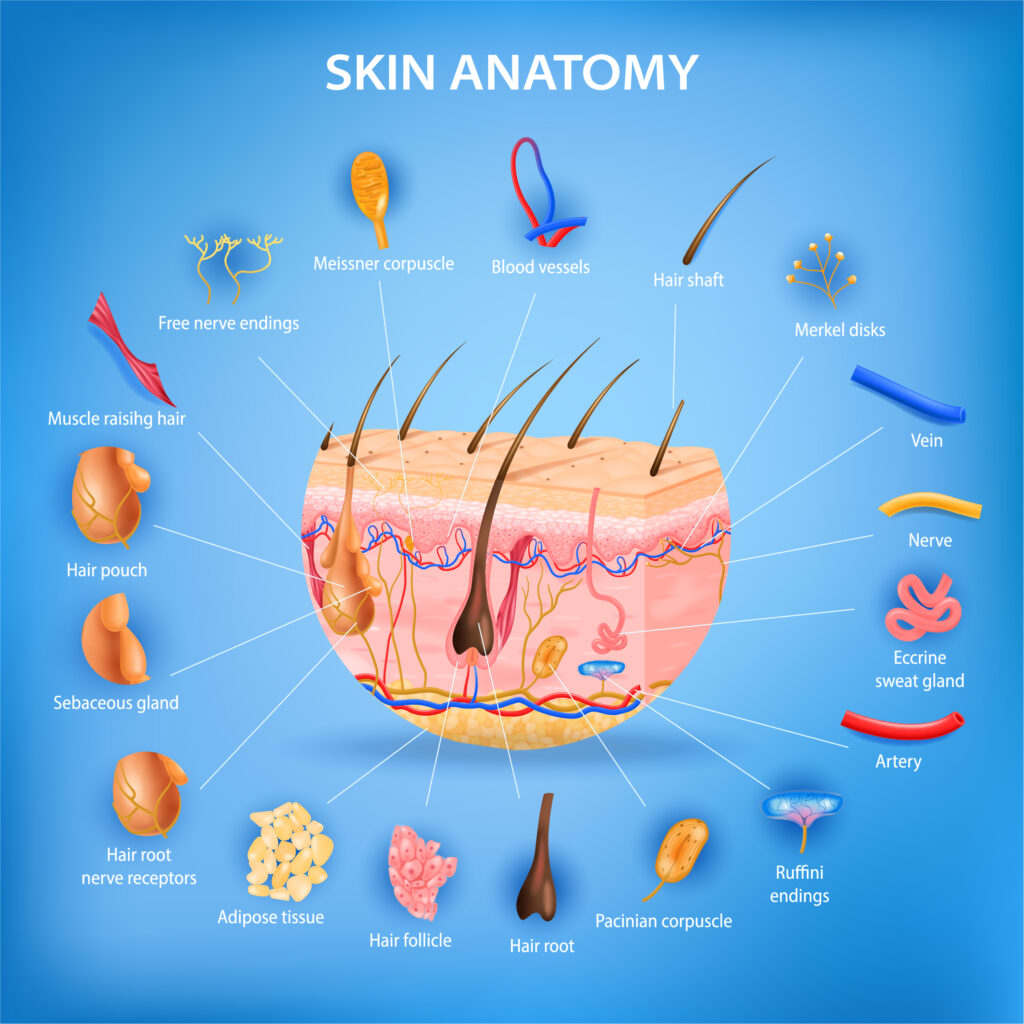Complexities of Skin Anatomy:
The skin, the body’s largest organ, serves as a multifaceted protective barrier while facilitating sensory experiences and regulating bodily functions. Comprising various layers and intricate structures, skin anatomy is a marvel of biological engineering. In this comprehensive guide, we will delve into the diverse components that constitute the skin, exploring each element in detail.

Layers of the Skin Anatomy:
Before diving into the specifics of skin components, it’s crucial to understand the three primary layers: the epidermis, dermis, and hypodermis (subcutaneous tissue). Each layer plays a distinctive role in supporting overall skin function.
1. Epidermis
The epidermis, the outermost layer, acts as a protective shield against external elements. Comprised mainly of keratinocytes, this layer undergoes continuous regeneration as old cells shed and new ones form. It also houses melanocytes responsible for skin pigmentation.
2. Dermis
Beneath the epidermis lies the dermis, a complex layer comprising collagen, elastin, nerve endings, blood vessels, and various appendages. It provides structural support, elasticity, and contains accessory structures such as hair follicles and sweat glands.
3. Hypodermis (Subcutaneous Tissue)
The hypodermis, situated beneath the dermis, primarily consists of adipose tissue (fat cells). It acts as an insulator, cushioning the body, storing energy, and connecting the skin to underlying muscles and bones.
Key Components of Skin Anatomy:
1. Hair Root and Hair Follicle
The hair root resides within the hair follicle, an invagination of the epidermis into the dermis. Hair follicles house the hair root, nourishing it with blood vessels and sebaceous glands, producing oils for hair lubrication.
2. Adipose Tissue
Primarily found in the hypodermis, adipose tissue insulates the body, cushions organs, and serves as an energy reservoir. Its presence beneath the skin contributes to its plumpness and shape.
3. Hair Root Nerve Receptors
Nerve endings surrounding the hair root act as sensors for touch and movement, aiding in sensory perception and facilitating responses to stimuli.
4. Sebaceous Gland in Skin Anatomy
Sebaceous glands, connected to hair follicles, secrete sebum, an oily substance that moisturizes and protects the skin and hair. An imbalance in sebum production can lead to skin issues like acne.
5. Hair Pouch and Muscle Raising Hair
Hair pouches are structures within the skin housing the hair root and its associated muscles. Muscles connected to hair follicles contract in response to stimuli (such as cold or fear), causing the hair to stand upright (goosebumps).
6. Free Nerve Endings, Meissner’s Corpuscle, Ruffini Endings, Pacinian Corpuscle, Merkel Disks
These nerve endings (free nerve endings, Meissner’s corpuscles, Ruffini endings, Pacinian corpuscles, and Merkel discs) are sensory receptors dispersed throughout the skin, each responsible for detecting specific sensations like touch, pressure, vibration, and texture.
7. Blood Vessels
Blood vessels, including arteries and veins, traverse the skin layers, ensuring nutrient delivery, waste removal, and temperature regulation. They also play a role in wound healing.
8. Eccrine Sweat Gland
Eccrine sweat glands, prevalent across the body, produce sweat to regulate body temperature through evaporative cooling, aiding in thermoregulation.
Understanding the complexity of skin anatomy illuminates its multifaceted role beyond being a mere protective layer. The intricate interplay of these components facilitates our sensory experiences, regulates bodily functions, and safeguards against external threats, making the skin a remarkable organ worthy of admiration and care.
Dermatology, as a medical specialty, revolves around the study, diagnosis, and treatment of conditions related to the skin, hair, nails, and mucous membranes. Understanding skin anatomy is fundamental to dermatology, as it forms the basis for comprehending various dermatological conditions and their treatments.
Clinical Relevance of Skin Anatomy in Dermatology:
- Hair Disorders: Knowledge of the hair root, follicle, and associated structures is crucial in diagnosing and treating hair-related issues such as alopecia (hair loss), folliculitis (inflammation of hair follicles), and hirsutism (excessive hair growth).
- Sebaceous Gland Dysfunction: Sebaceous glands play a pivotal role in conditions like acne vulgaris, where overactive sebaceous glands contribute to the formation of comedones, papules, and pustules.
- Nerve Endings and Sensory Perception: Understanding the distribution of nerve endings helps dermatologists diagnose neuropathies, nerve-related pain, and sensory disorders affecting the skin.
- Vascular Conditions: Blood vessels in the skin are crucial in diagnosing and treating vascular conditions like angiomas, telangiectasias, and vasculitis, which manifest as visible changes in blood vessel appearance or function.
- Sweat Gland Disorders: Eccrine and apocrine sweat gland dysfunction lead to conditions like hyperhidrosis (excessive sweating) or anhidrosis (lack of sweating), both of which can significantly impact a patient’s quality of life.
- Skin Cancer and Wound Healing: An understanding of skin layers, including the dermis and hypodermis, is vital in diagnosing skin cancers like melanoma, basal cell carcinoma, and squamous cell carcinoma. Additionally, knowledge of skin anatomy is crucial for wound assessment and healing.
- Allergic and Inflammatory Skin Conditions: Disorders such as eczema, psoriasis, contact dermatitis, and urticaria often involve various layers of the skin and its appendages, necessitating a deep understanding of skin anatomy for accurate diagnosis and management.
- Cosmetic Dermatology: Procedures like laser therapy, chemical peels, and cosmetic surgeries heavily rely on an understanding of skin layers, blood supply, and hair follicle distribution to achieve desired outcomes while minimizing risks.
In dermatology, a thorough understanding of skin anatomy is the cornerstone for accurately diagnosing and effectively treating a broad spectrum of skin-related conditions. By comprehending the intricate structures and functions of the skin, dermatologists can provide precise care tailored to individual patients, ensuring optimal skin health and well-being.
Conclusion:
the exploration of skin anatomy reveals its crucial role in dermatology and overall well-being. Understanding components like hair roots, glands, nerve receptors, and blood vessels is fundamental in diagnosing and treating skin conditions. This knowledge empowers dermatologists to provide tailored care, impacting not just skin health but also overall quality of life. Skin anatomy serves as a cornerstone for advancements in dermatological research, emphasizing the importance of nurturing and caring for this vital organ for improved health and wellness.

